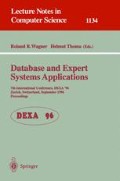Abstract
This paper presents a methodology for constructing hypertext views over existing relational databases. First, the database semantics are extracted in the form of an EER schema, using database reverse engineering techniques. Then, the EER schema is used for the definition of the node and link types of hypertext views. This two-stage approach has the benefit that the hypertext designer considers only a conceptual model of the database. Moreover, the instances of node and link types are dynamically computed; no data replication takes place. An experimental set of tools that support the methodology has been developed and used in a realistic case study.
Preview
Unable to display preview. Download preview PDF.
References
T. Barsalou, N. Siambela, A. M. Keller and G. Wiedelhold, “Updating Relational Databases through Object-Based Views”, ACM SIGMOD Conf. 1991, p. 248–257.
M. Castellanos, F. Saltor and M. Garcia-Solaco, “Semantically enrichment relational databases into an object-oriented semantic model”, Proc. of DEXA '94, Springer-Verlag LCNS 856, p. 125–134.
R. H.L. Chiang, T. M. Barron and V. C. Storey, “Reverse engineering of relational databases: Extraction of an EER model from a relational database”, Data & Knowledge Engineering 12, 1994, p. 107–142.
R. H.L. Chiang, “A Knowledge-based system for performing reverse engineering of relational databases”, Decision Support Systems 13, 1995, p. 295–312.
O. Drori, “Information Reduction Model in Hypertext Virtual Node”, ACM SIGLINK Newsletter 4(3), December 1995, p. 10.
R. Elmasri and S.B. Navathe, “Fundamentals of database systems”, Benjamin/Cummings, Menlo Park, CA, 1994.
C. Fahrner and G. Vossen, “A Survey of database design transformations based on the Entity-Relationship model”, Data & Knowledge Engineering 15, 1995, p. 213–250.
G. Falquet, J. Guyot and I. Prince, “Generating Hypertext Views on Databases”, CUI Technical Report No 101, University of Geneva, 1995.
M. Frank, “Database and the Internet”, DBMS Magazine 8(13), December 1995.
F. Garzoto, P. Paolini and D. Schwabe, “HDM: A Model-Based Approach to Hypertext Application Design”, ACM Trans. on Information Systems 11(1), January 1993, p. 1–26.
F. Halasz, “Reflections on Notecards: Seven Issues for the Next Generation of Hypermedia Systems”, CACM, 31(7), July 1988, p. 836–852.
F. Halasz and M. Schwartz, “The Dexter Hypertext Reference Model”, CACM 37(2), February 1994, p. 30–39.
Y. Hara and R. A. Botafogo, “Hypermedia Databases: A Specification and Formal Language”, Proc. of DEXA '94, Springer-Verlag LCNS 856, p. 520–530.
A. Hatzimanikatis, A. Papadopoulos and D. Christodoulakis, “Implementing Open Hypermedia Services on Top of the Postgres Extended Relational Database Management System”, Proc. of DEXA '94, Springer-Verlag LCNS 856, p. 531–539.
T. Isakowitz, E. A. Stohr and P. Balasubramanian, “RMM: A Methodology for Structured Hypermedia Design”, CACM 38(9), August 1995, p. 34–44.
V. M. Markowitz and J. A. Makowsky, “Identifying Extended Entity-Relationship Objects Structures in Relational Schemas”, IEEE Trans. on Software Engineering 16(8), August 1990, p. 777–790.
C. Ramananthan, “Providing Object-Oriented access to a Relational Database”, in Proceedings of the 32nd Annual Southeast Conf., Tuscalosa, Alabama, March 1994, p. 162–165, ACM Press.
W. J. Premerlani and M. R. Blaha, “An approach for reverse engineering of relational databases”, CACM 37(5), May 1994, p. 42–49.
D. Schwabe and G. Rossi, “Building Hypermedia Applications as Navigational Views of Information Models”, 28th Hawaii Int. Conf. on System Sciences, January 1995.
T. J. Teorey, G. Wei, D. L. Bolton and J. A. Koenig, “ER Model Clustering as an Aid for User Communication and Documentation in Database Design”, CACM 32(8), August 1989, p. 975–987.
F. W. Tompa, “A Data Model for Flexible Hypertext Database Systems”, ACM Trans. on Information Systems 7(1), January 1989, p. 85–100.
C. Varela and C. Hays, “Providing Data on the Web: From Examples to Programs”, Second International Conference on the World Wide Web, Chicago, October 1994.
C. Varela, “Zelig: Schema-Based Generation of Soft WWW Database Applications”, First Int. Conf. on the World Wide Web, Geneva, Switzerland, May 1994.
Author information
Authors and Affiliations
Editor information
Rights and permissions
Copyright information
© 1996 Springer-Verlag Berlin Heidelberg
About this paper
Cite this paper
Papadopoulos, A., Vaitis, M., Christodoulakis, D. (1996). Building hypertext interfaces to existing relational databases. In: Wagner, R.R., Thoma, H. (eds) Database and Expert Systems Applications. DEXA 1996. Lecture Notes in Computer Science, vol 1134. Springer, Berlin, Heidelberg. https://doi.org/10.1007/BFb0034688
Download citation
DOI: https://doi.org/10.1007/BFb0034688
Published:
Publisher Name: Springer, Berlin, Heidelberg
Print ISBN: 978-3-540-61656-6
Online ISBN: 978-3-540-70651-9
eBook Packages: Springer Book Archive

